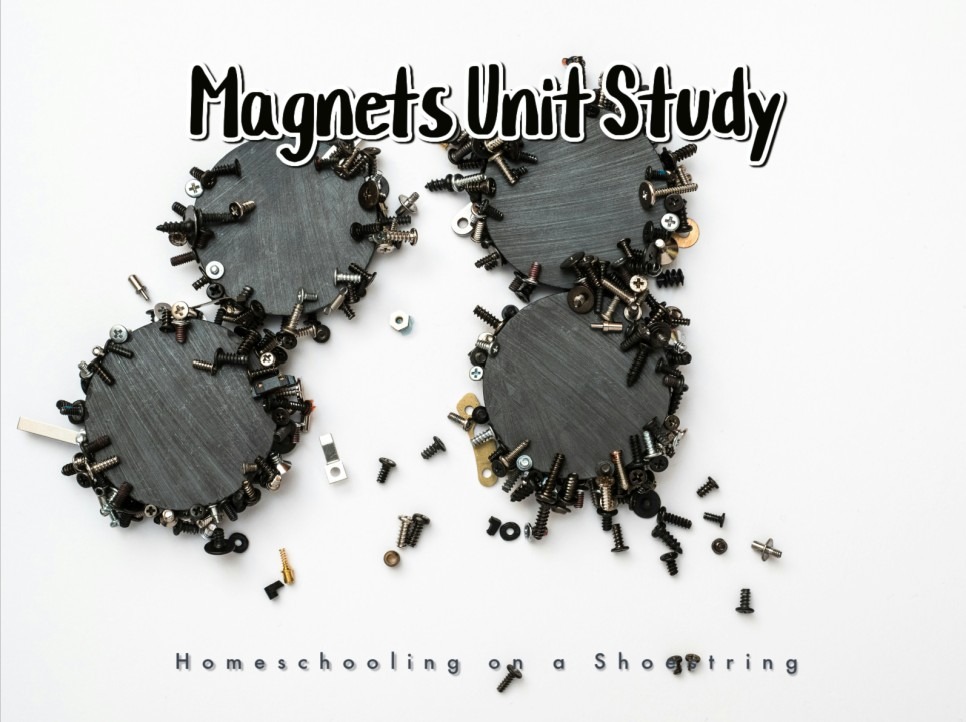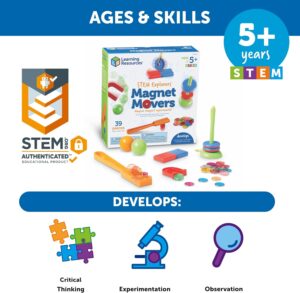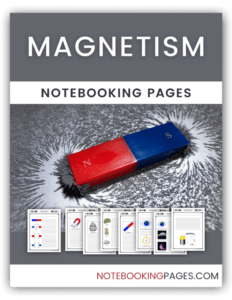
Magnets Unit Study
The unit is suitable for grades K–12, with flexibility to adapt based on your learners’ ages and abilities. Please preview links and activities to ensure they are appropriate for your family. New resources will be added as time allows.
Many of the links below lead to printable resources that can be added to a notebook or lapbook for this study.
This unit covers the basics of magnets and their uses in medicine, energy and space studies.
A magnet is made of materials that generate a magnetic field, and every magnet has both a North and South Pole. By convention, magnetic field lines exit the North Pole and enter the South Pole. This two-pole structure is called a magnetic dipole. Even if a magnet is broken into smaller pieces, each piece will still have both a North and South Pole. A true magnetic monopole—an isolated single pole—has never been observed.
The goal of this unit is to give students hands-on experience while learning about magnets. Through engaging experiments, students explore magnetic force and compass use. The unit emphasizes open-ended, thoughtful questions that encourage deeper exploration of the topic.
Caution about magnets and this unit
Please keep magnets away from recorded tapes (video or audio), watches, cell phones, computer hard drives, and similar devices. Magnets can realign particles on tapes and erase the content—if you have an old tape you’re discarding, try it as an experiment!
Also, be extremely cautious with small, strong magnets around young children. Ingested magnets can attract each other through intestinal walls, leading to dangerous perforations. This can be life-threatening and difficult to diagnose in time. Several toys have been recalled due to this risk. Treat magnets with the same care you would give any potentially hazardous material.
Previously worded as: Also be aware of the problems with children swallowing strong magnets. There have been many toys recalled because the small magnets, when swallowed, seek each other through folds in the intestines and actually perforate them. The children often die before the parents/doctors figure out what is wrong. It is like being shot in the stomach.
Learning Objectives
Many parents and teachers will need to create their own goals. You can compare the goals at these sites to create your own goals depending on how stringent your requirements need to be. All links have several suggested activities for different ages.
Suggested Curriculum Standards:
- World Book Scope Basic Course structure https://www.worldbook.com/free-educational-resources#tcos
- Michigan Department of Education https://www.michigan.gov/mde/services/academic-standards
- Maine as an example of state level requirements https://www.maine.gov/doe/ela/standards/index.html
- California state level requirements https://www.cde.ca.gov/be/st/ss/
- McREL Compendium National Level https://www2.mcrel.org/compendium/
- Ontario Canada K-8 Expectations https://www.dcp.edu.gov.on.ca/en/curriculum#elementary
- Abeka Scope and Sequence https://www.abeka.com/HomeSchool/ScopeAndSequence.aspx
- The series of books called “What your nth Grader needs to know” May also be helpful nth representing the grade your child is in. This series only Goes to grade 8
- Know that there are forces between magnets and that magnets can attract (pull towards) and repel (push away from) each other
- Make and record careful observations of magnets
- Know that magnets attract some metals but not others and that other materials are not attracted to magnets
- Magnetism is caused by the behavior of atoms in a magnet
- Using simple scientific instruments (magnets, magnifying glasses, and thermometers)
- Know the care and handling of magnets, magnifying glasses, thermometers and binoculars
- Know the types of magnets (horseshoe, U-shaped, bar and circle)
- Know that the magnetic field is stronger at the poles – north and south
- Know what a magnifying glass is and some common uses
- Know what a thermometer is and some common uses
- Know what a magnet is and some common uses
- Appreciate the importance of magnetism
- Identify a magnet based on their investigations and limited knowledge of what a magnet is capable of doing
- Understand that magnets are pieces of metal that have the power to attract other pieces of metal
- Understand that magnets attract objects made of iron or steel
- Understand that magnets have a ‘N’ and ‘S’ pole. Like poles push away or repel. Different poles pull together or attract
- Develop listening skills and demonstrate these skills
- Become familiar with terms and procedures related to topic
- Dramatize information learned about topic
- Evaluate information based on prior experiences and newly acquired knowledge
- Research a variety of documents to obtain knowledge
- Exercise critical thinking skills
- Learn to gather and use research information
- Create a notebook to demonstrate organizational skills
Bible References
Look up and compare scriptures at the sites below. In your journal, note how reading different translations and versions can deepen your understanding of each passage.
Bible Tools:
- American Standard Version https://ebible.org/asv/
- King James Bible in Mp3 https://www.audiotreasure.com/indexKJV.htm
- World English Bible in Mp3 https://www.audiotreasure.com/webindex.htm
- World Wide Study Bible https://www.ccel.org/wwsb
- E-Sword Bible Software. Free software that will allow you to compare many translations at the same time https://www.e-sword.net/
- New World Translation https://www.jw.org/en/library/bible/study-bible/books/
ISAIAH 40:22 Earth was described as round and global despite what humans thought
JOB 26:7 Earth hung upon nothing! Not atlas, not elephants standing on a turtles back
Vocabulary
| aluminum | force | nonmagnetic |
| atom | iron | North Pole |
| attract | lodestone | pick up |
| battery | magnetic | polarity |
| chemical | magnetism | poles |
| compass | magnetized | positive |
| electromagnetic | metal | repel |
| flux | negative | South Pole |
Vocabulary for Magnetism https://www.tooter4kids.com/Magnets/vocabulary_for_magnetism.html
Book Resources
Introduction to Magnets https://en.wikipedia.org/wiki/Magnet
Ferrite https://en.wikipedia.org/wiki/Ferrite_(magnet)
Highschool Textbook Link to Catalog page for Opportunities in High Magnetic Field Science https://nap.nationalacademies.org/catalog/11211/opportunities-in-high-magnetic-field-science
Opportunities in High Magnetic Field Science: Letter Report https://nap.nationalacademies.org/catalog/11211/opportunities-in-high-magnetic-field-science
Engaging Schools: Fostering High School Students’ Motivation to Learn https://nap.nationalacademies.org/read/10421/chapter/1
200 Gooey, Slippery, Slimy, Weird and Fun – by Janice Janice Van Cleave
Adventures in Science Series: Magnetism (Kit) – publisher: Educational Insights
Amazing Magnets – by David Adler
Awesome Experiments in Electricity and Magnetism – by Michael Dispezio
The Book of Magnets – by Mae Freeman
Driving Force: The Natural Magic of Magnets – by James D. Livingston
Electricity and Magnetism – by Robin Kerrod
Electricity and Magnetism – by Steve Parker
Electricity and Magnetism FUNdamentals – by Robert Wood
Electricity and Magnets – by Terry Cash and Barbara Taylor
Electricity and Power – by Peter Riley
Experiment With Magnetism and Electricity – by Margaret Whalley
Experimenting with Electricity and Magnetism – by Ovid Wong
Experiments with Magnets – by Helen Challand
Exploring Magnetism – by Neil Ardley
Hands On Science – publisher: Instructional Fair, Inc.
Hands-On-Minds-On-Science: Magnetism and Electricity – Teacher Created by Mel Feigen
How to Do Successful Science Projects – by Norman F. Smith
Junior Science Book of Magnets – by Rocco V. Feravolo
The Magnet Book – by Shar Levine and Leslie Johnstone
Magnet Science – by Glen Vecchione
Magnetic and Non-Magnetic – by Angela Royston
Magnetism – by Peter Riley
Magnetism – by Raymond Holden
Magnetism: A Question and Answer Book – by Richardson
Magnets – by Darlene Stille
Magnets – by Janice Van Cleave
Magnets – by Karen Bryant-Mole
Magnets – by Rena K. Kirkpatrick
Magnets – by Steve Parker
Magnets and Electricity – Carson Dellosa by Karen Siepak
Magnets: Pulling Together, Pushing Apart – by Natalie M. Rosinsky
Magnetude: Hours of Sticky Fun Without the Gooey Mess – by Bill Haduch
Mickey’s Magnet – by Franklyn M. Branley (a cute book for younger readers)
More Easy Physics Projects: Magnetism, Electricity, and Sound – by Rocco V. Feravolo
Mostly Magnets – AIMS Education Foundation
Physics for Kids: 49 Experiments with Electricity and Magnetism – by Robert Wood
The Science Book of Magnets – by Neil Ardley
Science Factory: Magnetism and Magnets – by Michael Flaherty
Science Magic with Magnets – by Chris Oxlade
The Science of Magnets – by Jonathan Bocknek
Science with Magnets – by Helen Edom
What Magnets Can Do – by Allan Fowler
What Makes a Magnet? – by Franklyn M. Branley
Poetry + Music
Experiment Songs (from Ballads for the Age of Science) – It’s A Magnet: https://open.spotify.com/album/08EMJ7QtiK1dOz6krCLni4
Singing Science Records: https://www.acme.com/jef/singing_science/
A science song for teaching about magnets: https://www.songsforteaching.com/intellitunes/magnets.htm
Video and Software Resources
Bill Nye The Science Guy video about magnets: https://www.youtube.com/watch?v=3B8qy8PYaGo
Games
Create a magnetic properties GeoSafari card. Ask “Is it magnetic?”
Hold a magnet under a table and one on the table and have races as a fun game.
Activities, Worksheets, Lesson Plans, and Pre-existing Units
- Grab two magnets and try putting their ends together—do they snap together or push away like magic?
- Reading Comprehension Magnets and Electromagnets: https://education.jlab.org/reading/magnets.html
- Magnetic Field Activities: 13-Day Unit Plan for High School Students: https://pwg.gsfc.nasa.gov/istp/outreach/ed/
- Explore Magnetic Storms: https://www.pbs.org/wgbh/nova/teachers/activities/3016_magnetic.html
- Make Your Own Generator: https://www.pbs.org/weta/roughscience/series1/challenges/generator/
- Converting Mechanical to Electrical Energy: https://www.pbs.org/tesla/tt/tt02.html
- Investigate Electromagnets: Research electromagnets: Learn why they work, how long a nail stays magnetic, how much weight it can hold (like paperclips or BBs), and more. Write a short report with illustrations.
- Mini Study on the History of Magnets: Do a quick study on the history of magnets and record your findings in your journal.
- Magnet Experiments: Perform several experiments with magnets and record your findings in your journal.
Fun Questions for Exploration
- Bobby dropped some thumbtacks into a fish tank. How could he get the thumbtacks out without getting his hands wet?
- Jill wants to move a paperclip across her desk without touching it. How can she make the paperclip move—almost like magic?
- Alice dropped a sewing needle on the couch and can’t see it. What’s a quick and safe way to find it?
- Bill’s dad dropped a metal screw in the rain gutter and can’t reach it. How can you help him get it out without damaging the gutter?
- Mike’s uncle gave him a jar full of marbles, quarters, and metal washers. How can he separate the metal items without touching them?
- Betty taped a magnet to her toy car and moved it with another magnet. How do you think she did that? What made the car move?
Magnetism Resources for Younger Grades
- Amazing Magnets (Grade 2): https://www.coreknowledge.org/wp-content/uploads/2016/11/Amazing-Magnets-Constructivism-and-Science-in-the-Core-Knowledge-Sequence.pdf
- Marveling in Magnets (Grade 2): https://www.coreknowledge.org/wp-content/uploads/2016/11/MARVELING-IN-MAGNETS.pdf
- May the Force Be With You (Grade 2): https://www.coreknowledge.org/wp-content/uploads/2016/11/MAY-THE-FORCE-BE-WITH-YOU.pdf
- Magnet Word Search, Vocabulary, Crossword, and More!: https://www.thoughtco.com/free-magnets-printables-1832413
- Magnetism and Its Properties (Grades K-3): https://www.eduref.org/lessons/science/phs0001
- Learn Magnet Basics (Grades 2-3): https://www.eduref.org/lessons/science/phs0203
- Magnetism Reading Comprehension: http://www.myschoolhouse.com/courses/O/1/33.asp
- Magnetism Web Quest: https://www.angelfire.com/scifi/dschlott/magwebq.html
- Magnetism History Fundamentals: https://physics.info/magnetism/
- Planetary Magnetism: https://www.astronomynotes.com/solarsys/s7.htm
- How Compasses Work: https://www.mapquest.com/travel/outdoor-activities/hiking/compass.htm
- Create experiments to show how magnets work. Test which materials are attracted and whether magnets affect non-metals. Highlight their “magic” and real-world uses in your display. https://www.scienceproject.com/projects/intro/elementary/EP010.asp
- Magnetic Properties (Gr. 2) https://teachers.net/lessons/posts/3652.html
- The Girl Scout Brownie Try-it Science Wonders Magnet Hunt: Magnets pull some things to them. Most magnets are made of iron and come in many different shapes. Get a magnet and find out what will stick to it. https://scoutshonor.fandom.com/wiki/Science_Wonders_(Brownie_Try-it)#Magnet_Hunt
- Magnetic Poetry: Try using magnetic poetry with your spelling words.
More Magnet Fun
Magnetic Motor: https://simplemotor.com/assembly-instructions/reed-switch-motor-made-with-household-materials/
How a Metal Detector Works: https://micro.magnet.fsu.edu/electromag/java/detector/
How Electromagnets Work: https://science.howstuffworks.com/electromagnet.htm
Science Fair Projects and Experiments: https://www.juliantrubin.com/topicprojects/magnetprojects.html
Famous People in Energy & Science: https://www.eia.gov/kids/history-of-energy/famous-people/
Online Activity
Interactive Plasma Physics Education Experience: https://ippex.pppl.gov/
Online video with review questions and activities about the Electromagnetic Spectrum: https://www.brainpop.com/topic/electromagnetic-spectrum/
Experiments
Make Your Own Compass: https://oceanservice.noaa.gov/education/dyw-make-compass.html | https://www.amnh.org/explore/ology/earth/create-a-compass2 | https://www.nps.gov/articles/compass.htm
Experiments you can do with permanent magnets and electro-magnets: https://www.coolmagnetman.com/magindex.htm
Make iron filings (file an old iron nail) and then use fridge magnets to demonstrate the magnetic fields. Watching the filings jump is also such fun.
A series of experiments about electricity and magnetism (Gr. 4): http://web.archive.org/web/20040603203002/www.galaxy.net/~k12/electric/
Exploratorium Science Snacks Magnets: https://www.exploratorium.edu/snacks/tag/magnet
How to Make Liquid Magnets – Things to Do with Ferrofluid: https://www.thoughtco.com/how-to-make-liquid-magnets-606319
Art and Craft Ideas
Make Magnetic Crafts that work with your other units.
Use magnetic paint on your file folder games to take them in the car.
Coffee Filter Fridge Magnets: https://kinderart.com/art-lessons/crafts/coffee-filter-tissue-butterflies/
Magnetic Dolls: Create and decorate magnetic dolls from magnet sheet with outfits that can be attached to magnets and stored in metal tins or on the fridge.
Information
NASA Magnetics – Exploring Earth’s Magnetic Fields for grades 3-12. This book encourages curiosity about the Sun-Earth connection, focusing on how Earth’s magnetic field responds to solar activity. It blends hands-on experiments with online satellite data to give students a well-rounded view of current Sun-Earth research: https://science.nasa.gov/wp-content/uploads/2023/09/Exploring_Earth_s_Magnetic_Fields.pdf
This educator guide offers hands-on activities with built-in math challenges to explore magnetism and magnetic fields: https://science.nasa.gov/learn/heat/resource/magnetic-math/
Magnets, including a history: https://www.tooter4kids.com/Magnets/Index.html
How Magnetic Resonance Imaging (MRI) works: <a href=”https://science.howstuffworks.com/mri.htm”>https://science.howstuffworks.com/mri.htm</a>
The Compass and Other Magnetic Innovations: https://www.thoughtco.com/compass-and-other-magnetic-innovations-1991466
Commercial Sites
Worksheets
Make your own worksheets with these worksheet creation tools:
- SchoolHouseTech https://www.schoolhousetech.com/ This company gives away two free software worksheet factories one for Basic math and one for wordsearch utility that will make wonderful complements to this unit when you include the clipart listed in the clipart section.
- Start Write – This program makes nice reports and handwriting worksheets for the unit. https://www.startwrite.com/
- TeachNology has several online worksheet makers and a ton of Rubric makers. Rubrics work great with Homeschool Tracker because they give you total points and you count up exactly how many points your child gets. https://www.teach-nology.com/worksheets/
- Online Crossword Puzzle Maker to use with your vocabulary words or locations or even dates from the timeline. https://www.happychild.org.uk/wks/english/ssm/crosswords01.htm
Evaluation Ideas
Assemble a three ring binder and please include:
- A copy of this unit
- Course Description (Highschool Students)
- Write a summary about books read for the unit
- Write an essay on the various topics discussed
- Your Lapbook created for the unit (K-8 Students)
- Any worksheets or activity books created with SchoolhouseTech Software https://www.schoolhousetech.com/
- Your journal and its contents
- Your Log of activities from Homeschool Tracker https://www.homeschooltracker.com/free-homeschool-tracker-basic-edition Its Free!
- Your Timeline
Affiliate Links
| Amazon | NotebookingPages.com |
|---|---|
 |
 |
| Kids Learn Magnet Science |  |
Unit Safari Magnets Unit was originally compiled July 29, 1999, with revisits November 2004 and May 14, 2007.
![]()
